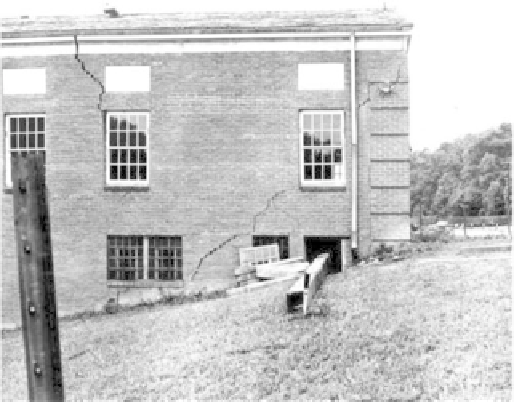Environmental Engineering Reference
In-Depth Information
inches to feet per year in 1995. The salt bed, about 30 ft thick, was mined for many years
by the room and pillar method where 40 to 50% of the salt was left in place. The collapse
occurred in an area of the mine where smaller pillars, known as yield pillars, were used
to maintain the mine roof (MSHA, 1995). Gowan and Trader (2000) suggest that an
anomalous buildup of natural gas and brine pressure above the collapse area con-
tributed to the failure.
Coal Mining
From the aspects of frequency of occurrence and the effects on surface structures, coal min-
ing appears to be the most important subsurface mining operation. Mine collapse results
in irregular vertical displacement, tilting, and horizontal strains at the surface, all result-
ing in the distortion of structures as illustrated in
Figure 10.6.
The incidence and severity
of subsidence are a function of the coal bed depth, its thickness, percent of material
extracted, tensile strength of the overburden, and the strength of pillars and other roof
supports. InSAR (Section 2.2.3) is being used in Poland and other locations in Europe to
monitor subsidence from coal mining.
General methods of extraction and typical subsidence characteristics include:
The longwall panel method is used in Europe, and is finding increasing use in
the United States. It involves complete removal of the coal. Where the mine is
relatively shallow and the overlying materials weak, collapse of the mine, and
surface subsidence progress with the mining operation. Subsidence is in the
form of a large trough which mirrors, but is larger than, the plan dimensions of
the mine.
●
The room and pillar method has been used in the United States. Pillars are left in
place to support the roof, but subsequent operations rob the pillars, weakening
support. Collapse is often long term. Subsidence takes the forms of sinkholes
(pits) or troughs (sags).
●
Most states have prepared detailed “Codes” relating to underground mining; for exam-
ple, in Pennsylvania, Code 89.142a adopted in 1998 refers to “Subsidence Control:
Performance Standards.”
FIGURE 10.6
Building damaged by mine subsidence
in Pittsburgh. (Photo courtesy of
Richard E. Gray.)



